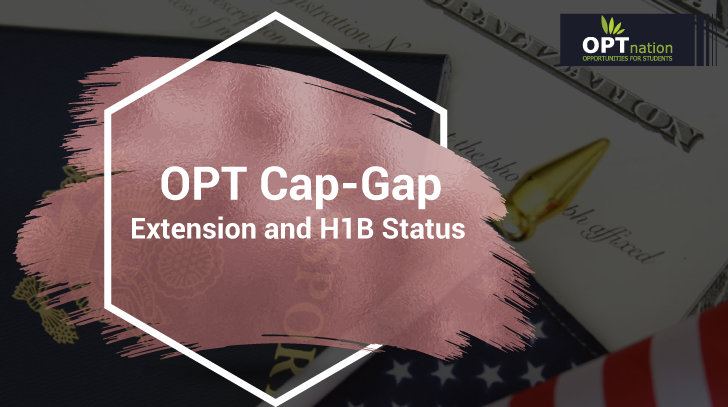United States Citizenship and Immigration Services (USCIS) provides the “cap-gap” of employment authorization which means it allows an extension of an eligible F-1 student’s status to see through the gap between the end of their student OPT status and the commencement date of their approved H-1B employment this means the “cap-gap” period occurs when a student’s F-1 status and/or OPT expire before their approved H-1B unless terminated, ends on October 1. The student under cap-gap extension is offered employment authorization and is the beneficiary if the opt is expired and H1B is pending or approved H1B visa petition.
Cap-gap Extension Eligibility:
The cap-gap extension is available at the beginning of each fiscal year, i.e. April 1st, to the students who were either on approved OPT, or are within their sixty day grace period, have a pending or approved change of status October 1st H-1B petition with the USCIS that was filled beforehand to the expiration of their OPT or sixty day grace period. If you filed your petition before your EAD expired (April 1st – September 30th)
How to Apply?
Since there are two types of Cap-gap extensions, H-1B petitions that have been filed and receipted and H-1B petitions that have been filed but not receipted, they both follow different procedures. Here’s an overview:
H-1B petitions that have been filed and receipted: If your H-1B or change of status petition has been rejected by USCIS, you will be considered eligible for an automatic cap-gap extension 1-20 through September 30th. In order to request this, access the “H-1B Cap Gap Extension I-20 Request” in your SEVIS hub. There, you must upload the following:
- Your 12 month EAD or STEM EAD card
- A copy of the I-797 Receipt or Approval notice from USCIS
Choose your preferred delivery method and it will process within 5 business days.
Petitions that have been filed but NOT receipted: If your employer has filed your H-1B or change of status petition but has not receipted, and your OPT expires before 1st June, then you are eligible for a preliminary cap-gap extension until June 1st. You can request for an automatic cap-gap extension 1-20 (once your petition is receipted) by following these steps:
Access the “H-1B Cap Gap Extension I-20 Request” in your SEVIS hub and upload your 12 month EAD or STEM EAD card. Upload a copy of FedEx, UPS, or USPS Express/certified mail receipt and delivery confirmation which shows your timely filed H-1B application to USCIS. Select your preferred delivery method and it will be processed within 5 working days.
Traveling on the cap-gap extension:
Students with H-1B petitions that are pending and who possess cap-gap benefits should not travel. The main reason for this is that their change of status request will be considered abandoned if they are a foreign national who travels during this period. Without the pending change-of-status request, they will no longer be eligible for cap-gap relief.
However, if a student must travel outside of the USA during the cap-gap period then they should have a valid Employment Authorization Document or EAD, a valid passport F-1 visa, signed I-20, and employer letter to present upon re-entry. If EAD is expired, then the entry in United States will not be granted based only on your cap-gap extension.
Whenever a person look for entry in the United States, their admissibility is determined at the time they apply for admission at a port of entry. U.S. Customs and Border Protection make such decisions after carefully inspecting the applicant for admission. For an individual who traveled during the cap-gap extension period, they must be prepared to apply for or an H-1B visa outside the U.S. and adjust return travel plans accordingly. According to the H-1B regulations, entry to the U.S. is permitted only up to 10 days prior to October 1st.
OPT Jobs for International Students:
For international students in the USA there are two employment options – Optional Practical Training (OPT) and H-1B Visa. OPT allows graduate or undergraduate students on F-1 visa to take up temporary employment for a period of 12 months that goes with their field of study. The types of employment during the 12 months period of OPT are:
Paid Employment – Students may work part time or full time in a job which goes with what they studied.
Multiple employers – They can work for more than one employer, however, their employment must be related to their degree program.
Short-term Multiple employers (Performing artists) – Students, such as actors, musicians or other performing artists are allowed to work for multiple short term employers (gigs).
Work for hire – Students are allowed to perform a service based on contractual relationship than employment relationship.
Self-employed business owner – With proper business licenses students can start their own business and work full time (20 hours maximum per week)
Employment through an agency – If employed by an agency, student must provide evidence that they worked for an average of at least 20 hours per week.
Unpaid employment – Students can also volunteer as unpaid interns or volunteers, provided it does not violate any labor laws. However, the work must be at least 20 hours/week.
It is important to note that these types of employments do not apply to STEM Extension.
Conclusion: With OPT jobs growing in large numbers, one must be extra careful and cautious in choosing the right OPT employer. Look out for comprehensive Training and Placement programs for OPT students that suit your requirement and do a thorough research before picking one.

